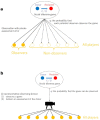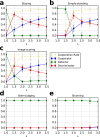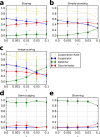Tolerant indirect reciprocity can boost social welfare through solidarity with unconditional cooperators in private monitoring
- PMID: 28852005
- PMCID: PMC5575281
- DOI: 10.1038/s41598-017-09935-2
Tolerant indirect reciprocity can boost social welfare through solidarity with unconditional cooperators in private monitoring
Abstract
Indirect reciprocity is an important mechanism for resolving social dilemmas. Previous studies explore several types of assessment rules that are evolutionarily stable for keeping cooperation regimes. However, little is known about the effects of private information on social systems. Most indirect reciprocity studies assume public monitoring in which individuals share a single assessment for each individual. Here, we consider a private monitoring system that loosens such an unnatural assumption. We explore the stable norms in the private system using an individual-based simulation. We have three main findings. First, narrow and unstable cooperation: cooperation in private monitoring becomes unstable and the restricted norms cannot maintain cooperative regimes while they can in public monitoring. Second, stable coexistence of discriminators and unconditional cooperators: under private monitoring, unconditional cooperation can play a role in keeping a high level of cooperation in tolerant norm situations. Finally, Pareto improvement: private monitoring can achieve a higher cooperation rate than does public monitoring.
Conflict of interest statement
The authors declare that they have no competing interests.
Figures







Similar articles
-
A solution for private assessment in indirect reciprocity using solitary observation.J Theor Biol. 2018 Oct 14;455:7-15. doi: 10.1016/j.jtbi.2018.06.018. Epub 2018 Jul 3. J Theor Biol. 2018. PMID: 29997059
-
Global analyses of evolutionary dynamics and exhaustive search for social norms that maintain cooperation by reputation.J Theor Biol. 2007 Feb 7;244(3):518-31. doi: 10.1016/j.jtbi.2006.08.018. Epub 2006 Sep 1. J Theor Biol. 2007. PMID: 17030041
-
Evolutionary stability of cooperation in indirect reciprocity under noisy and private assessment.Proc Natl Acad Sci U S A. 2023 May 16;120(20):e2300544120. doi: 10.1073/pnas.2300544120. Epub 2023 May 8. Proc Natl Acad Sci U S A. 2023. PMID: 37155910 Free PMC article.
-
Effect of private information on indirect reciprocity.Phys Rev E Stat Nonlin Soft Matter Phys. 2010 Sep;82(3 Pt 2):036111. doi: 10.1103/PhysRevE.82.036111. Epub 2010 Sep 23. Phys Rev E Stat Nonlin Soft Matter Phys. 2010. PMID: 21230143
-
Four levers of reciprocity across human societies: concepts, analysis and predictions.Evol Hum Sci. 2022 Feb 21;4:e11. doi: 10.1017/ehs.2022.7. eCollection 2022. Evol Hum Sci. 2022. PMID: 37588908 Free PMC article. Review.
Cited by
-
Adherence to public institutions that foster cooperation.Nat Commun. 2021 Jun 11;12(1):3567. doi: 10.1038/s41467-021-23783-9. Nat Commun. 2021. PMID: 34117236 Free PMC article.
-
When do stereotypes undermine indirect reciprocity?PLoS Comput Biol. 2024 Mar 1;20(3):e1011862. doi: 10.1371/journal.pcbi.1011862. eCollection 2024 Mar. PLoS Comput Biol. 2024. PMID: 38427626 Free PMC article.
-
Experimental evidence of selective inattention in reputation-based cooperation.Sci Rep. 2018 Oct 4;8(1):14813. doi: 10.1038/s41598-018-33147-x. Sci Rep. 2018. PMID: 30287848 Free PMC article.
-
Evolution of empathetic moral evaluation.Elife. 2019 Apr 9;8:e44269. doi: 10.7554/eLife.44269. Elife. 2019. PMID: 30964002 Free PMC article.
-
Reputation structure in indirect reciprocity under noisy and private assessment.Sci Rep. 2022 Jun 22;12(1):10500. doi: 10.1038/s41598-022-14171-4. Sci Rep. 2022. PMID: 35732644 Free PMC article.
References
-
- Sparks A, Barclay P. Eye images increase generosity, but not for long: the limited effect of a false cue. Evol. Hum. Behav. 2013;34:317–322. doi: 10.1016/j.evolhumbehav.2013.05.001. - DOI
-
- Frank, R.H. Passions within reason; The strategic role of he emotions (New York: Norton, 1988).
-
- Zahavi A. Altruism as a handicap: The limitations of kin selection and reciprocity. J. Avian Biol. 1995;26:1–3. doi: 10.2307/3677205. - DOI
Publication types
LinkOut - more resources
Full Text Sources
Other Literature Sources

